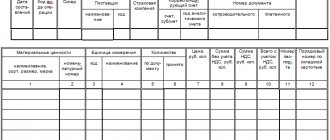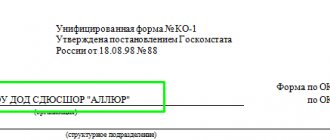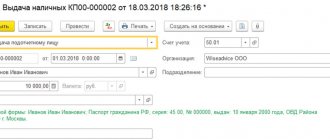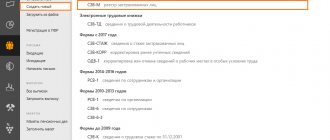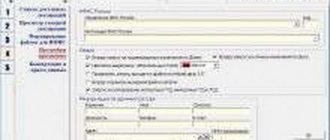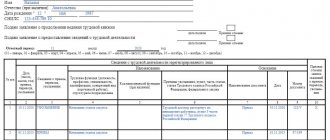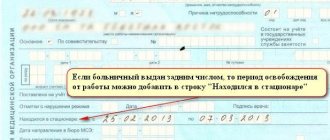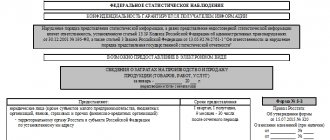The availability and consumption of goods and materials received by the organization under contracts and agreements must be recorded. Accountants must draw up a receipt order in form M-4. How to form it?
Dear readers! The article talks about typical ways to resolve legal issues, but each case is individual. If you want to find out how to solve your particular problem , contact a consultant:
8 (800) 700 95 53
APPLICATIONS AND CALLS ARE ACCEPTED 24/7 and 7 days a week.
It's fast and FREE !
When there is a lack of receipt orders for materials in the M-4 form in the organization’s documentation, the Federal Tax Service may bring charges of violation of the law.
In this case, value added tax may be withheld from the enterprise and a fine may be imposed. How to correctly form a receipt order in form M-4?
General rules for filling out the Receipt Order
When filling out the Receipt Order, you must consider the following.
- All fields in the document must be completed.
- If there is no data in the column, a dash is placed
- The unit of measurement code is filled in in accordance with the All-Russian Classifier of Units of Measurement.
- If an organization takes into account the type of inventory data in units of measurement different from those specified in the supplier’s documents, the quantity is indicated in two units of measurement. First - in those units specified by the supplier, then in those installed in the organization. If the organization has developed and approved a system for converting from one unit to another, then the quantity can be indicated in the units of measurement adopted in the organization and a link to the relevant local regulation can be given.
- When a smaller/larger unit of measurement is indicated in the supplier's documents, the materials are accepted in the unit of measurement accepted by the organization.
- When accepting MPZ containing precious metals, the column “Passport number” is filled in; in other cases, a dash is placed in this column.
Legal regulation
Federal Law No. 129 of November 21, 1996 “On Accounting” in Article 9 includes a requirement for the need to document all management transactions with primary documentation.
Resolution of the State Statistics Committee of the Russian Federation No. 71a dated October 30, 1997 established a primary document for the posting of enrolled materials. Such a document is the form of receipt order M-4.
According to clause 49 of the “Methodological guidelines for accounting of inventories”, ratified by Order of the Ministry of Finance of the Russian Federation No. 119n dated December 28, 2001, an M-4 order accompanies any crediting of materials.
Organizations that, in addition to trade, are engaged in other types of activities must receive and receive goods in the same way as the procedure for registering material objects.
This is provided for in paragraph 224 of the above Guidelines. It is important that this procedure should not be followed by entities conducting only trading activities.
According to Article 9 of Federal Law No. 129, the receipt order M-4 specifies the date of receipt, the number of material assets and other essential details.
If receipt orders are not used in accounting, tax authorities have the right to make claims regarding shortcomings in the primary documentation and cancel the deduction of input VAT.
According to clause 3 of Article 120 of the Tax Code of the Russian Federation, failure to draw up primary documentation is considered a gross violation of the standards for accounting for income/expenses and taxable items.
The fine under this standard varies from five to fifteen thousand rubles. If the tax base is understated, the amount of penalties is equal to ten percent of the amount of unpaid tax, but not less than fifteen thousand rubles.
If the material assets received are capitalized without generating a receipt order, this may be taken into account as an understatement of the tax base.
For any business transaction, it is necessary to draw up primary documents with the presence of mandatory details. Only after proper preparation can the documents be accepted for accounting, and the business operation reflected on the accounting accounts.
From which it follows that the receipt of material assets on the organization’s balance sheet is reflected in the accounts only after drawing up the M-4 receipt order.
After this, the entity has the right to use the deduction of input VAT if other conditions for offset are met.
Registration deadlines
There are cases of large volume deliveries of goods during the day. The legislation allows you to draw up one receipt document, and enter all goods into it as they are received until the end of the working day. However, these must be homogeneous goods (for example, raw materials or semi-finished products of a certain group).
NOTE. The order is issued only on the day the goods or raw materials arrive. Accordingly, it must be drawn up upon receipt before the end of working hours.
Thus, an order must be drawn up only in the event of further use of goods and raw materials for the production of new products .
And if the company is engaged in their sale, then it is enough to simply use the invoices for the goods and affix the organization’s stamp.
Purpose
Issued to confirm all transactions related to the receipt of goods from the supplier, as well as materials subsequently used for the production of products. In accounting, it is determined that it is the receipt order that represents the main document, which reflects the fact of acceptance of goods for subsequent warehouse accounting.
At the same time, a receipt is issued in all cases when they receive:
- the actual product;
- raw materials for production processes;
- semi-finished products for further sale and/or use in production, as well as food preparation.
Along with this appointment, the receiver plays a big role in the case of registering goods for storage in a warehouse. It is on the basis of the data in this document that a material storage record card is compiled (form M-17 is approved by law).
Moreover, if goods or raw materials, technical materials are purchased, which will later be used for production purposes, then the receipt order is the only primary reporting document that confirms the fact of receipt.
Registration deadlines
There are cases of large volume deliveries of goods during the day. The legislation allows you to draw up one receipt document, and enter all goods into it as they are received until the end of the working day. However, these must be homogeneous goods (for example, raw materials or semi-finished products of a certain group).
NOTE. The order is issued only on the day the goods or raw materials arrive. Accordingly, it must be drawn up upon receipt before the end of working hours.
Thus, an order must be drawn up only in the event of further use of goods and raw materials for the production of new products. And if the company is engaged in their sale, then it is enough to simply use the invoices for the goods and affix the organization’s stamp.
Requirements for placing an order
The M-4 receipt order form was developed by the State Statistics Committee and approved by the 1997 Resolution. This document records all receipts of materials that come to the organization from suppliers or from processing departments.
The order must be filled out by the financially responsible employee; this document is drawn up upon receipt of inventory materials for warehousing, as well as upon transfer of semi-finished products for use in production. The order must be drawn up in a single copy: this document specifies the quantity of materials received by the unit. One order can be issued for several types of incoming products if they are transferred to the enterprise by one supplier and delivered within one day.
The form can be filled out manually, but more often automated computer programs are used for this. Electronic filing saves time and ensures accurate records
The procedure for filling out a cash receipt order
The cash receipt form is issued in one copy by an accounting employee and signed by the chief accountant or a person authorized to do so.
In this case, the receipt for the cash receipt order is signed by the chief accountant or a person authorized to do so, and by the cashier, certified by the seal (stamp) of the cashier.
Step-by-step filling instructions
- serial number of the form and the date of its preparation;
- name of the organization and department receiving the materials;
- Next, indicate the name of the supplier and, if available, the insurance company. The insurance company is indicated only when the cargo is insured. Otherwise, either a dash is placed in this column, or it remains empty;
- As for encodings - “Operation code”, “Supplier code”, etc. - these columns are rarely filled in by representatives of small businesses, since they usually do not approve the internal classifier of such codes. Therefore, in these columns they either make a dash or leave them empty;
- then the storekeeper enters the number of the accompanying document in the column of the same name. The data is taken from the invoice.
As soon as filling out this tabular part of the order is completed, the storekeeper begins the descriptive part
:
All these columns are filled in in one document for several types of materials, if they were received by the enterprise under one invoice. That is why at the end, on the reverse side of the M4 receipt order, the total is summarized only by cost indicators.
If materials were received using different invoices, then a separate receipt order is created for each delivery.
The exception is delivery made during the day, of homogeneous goods and from one supplier. In this case, a general receipt order is issued.
As for such columns as “Corresponding account” and “Payment document number”, they are usually filled out by the accounting department based on its data.
The order is signed by the storekeeper and by the one who brought the materials from the supplier, from processing, or hands them over to the warehouse upon receipt for other reasons.
Step-by-step instructions for registering a receipt order in 1C are presented in the following video lesson:
Receipt order M-4 is the primary document confirming the receipt of goods and materials into the warehouse. Let's figure out when the M-4 form is used and consider an example of filling out an M4 receipt order. Here you can in excel.
Read in the article:
A receipt order in form M 4 is issued at the time of capitalization of inventory items coming from the counterparty or from processing. But at the same time, the quantity and quality of materials must be identical to the information given in the shipping documents.
As a rule, a receipt order M4 is issued for each delivery. But there are also cases where you can issue one order to receive several items of inventory and materials. Such cases include admission:
- Inventory and materials from one supplier using one invoice;
- homogeneous materials from one supplier using different invoices within one day.
Receipt order M 4 is drawn up in one copy by warehouse workers. The warehouseman and the person who delivered the goods and materials to the warehouse (in particular, the forwarder or driver) put their signatures on the document.
After filling out the M4 form, it is sent to the accounting department along with other shipping documents.
Who can sign the document
Certification of the order with the signature of an authorized person is a mandatory requirement. Moreover, the signature of the financially responsible employee who has the right to accept the goods is affixed. If such a person is absent, the authority is transferred to another employee. In case of a long absence (business trip, vacation, etc.), a power of attorney may be drawn up to perform such actions.
The document is considered finally accepted after the signature is placed. Accordingly, no corrections can be made to it after this. And at the time of signing, all empty columns must be crossed out. Even small amendments will lead to the order becoming invalid, so a new one will have to be drawn up.
After this, the operation is reflected in the accounting documents, and the document itself is sent to the archive and is provided only at the request of the inspectors.
Document for issuing funds
The expenditure order is also issued in one copy. When issuing funds to an employee for reporting, the form should be drawn up in accordance with his written application. It can be in free form. The application must be signed by the head of the enterprise. It states:
The “Base” field indicates the operation performed. For example, this could be “refund of overexpenditure according to report No. 123 dated March 2, 2017.” In the “Attachment” field, primary and other documents are indicated. At the same time, their numbers and dates of compilation are given. Applications can be applications for the issuance of funds, invoices, and so on. Rules for registration f. KO-2 are provided for in the Methodological Recommendations approved by Goskomstat Resolution No. 88. It is not allowed to make any corrections to the expenditure order. The document is also signed by the chief accountant, manager or other person authorized by him. Entrepreneurs who keep records of costs and income or physical indicators, according to tax legislation, may not issue expense vouchers.
Filling out the receipt order form M-4
Form M-4 was approved by Decree of the State Statistics Committee of the Russian Federation dated October 30, 1997 No. 71a. The form is double-sided and includes information about the seller company, the buyer and the product being purchased.
First you need to fill out the header of the document. Enter the serial number of the M-4 form, according to the company’s internal document flow. Then fill in the name of the purchasing company in full, indicating the organizational and legal form, OKPO code and structural division of the company.
The first page of Form M-4 contains 2 tables. The first table contains the following information:
- date of filling out the form;
- transaction type code;
- name of the warehouse;
- information about the supplier: name and code;
- information about the insurance company;
- Correspondent account data: account, subaccount and analytical accounting code;
- document data: number of accompanying and payment document.
The second table contains detailed data about the incoming goods. It includes 12 columns:
- name of the value, its characteristics: color, grade, etc.
- item number of value;
- then the code of the unit of measurement is indicated;
- name of the unit of measurement;
- number of values according to documents;
- the number of values actually accepted;
- price of goods received in form M-4;
- amount in rubles excluding VAT;
- VAT amount;
- amount including VAT;
- passport ID;
- number in order according to the warehouse card index.
The table contains quite a lot of rows. Unfilled lines must be crossed out - for example, crosswise.
The last line of the receipt order table f.M-4 summarizes the total data on the quantity of goods, the price of goods (cost excluding value added tax, VAT amount, total amount, which includes tax).
The document is signed by the responsible employee who accepted the goods - the position of the receiver and the transcript of the signature are indicated. And the responsible employee who handed over the goods - also indicating the position and decoding of the signature.
The receipt of material assets at the company's warehouse may be accompanied by the execution of a receipt order of the standard form M-4. This form will be transferred to the accounting department as a basis for making the necessary entries to accept materials for accounting.
The receipt form is filled out at the warehouse upon receipt of material assets from the supplier. If several batches of materials are received from the same supplier in one day, then all of them can be reflected in one M-4 form.
General drafting rules
When receiving several types of material using one invoice, you can create one receipt order. But the main thing is to draw up the document correctly.
To do this, you need to know what information is required to be provided:
| Code by type of operation | You only need to enter the code if the receiving party has a classifier for the types of operations. If there is no such classifier, a dash is placed in this line |
| Code by supplier | This code is indicated if the economic entity has a classifier for supplier codes. The absence of a classifying document requires a dash to be placed in this line |
| Insurance organization | The name of the insurance company that insured the received object is written here. If there is no insurance, a dash is indicated |
| Number value of the accompanying document | The number of the document on the basis of which the materials were credited is indicated. This may be an invoice from the supplier or a delivery note |
| Number corresponding to the payment document | Write down the number of the document according to which the materials were paid for. This may be considered a payment request or order |
| Price (7 columns) | The cost value for one unit of the accepted object is written down, excluding VAT. |
| VAT amount (9 columns) | The VAT amount is shown for the entire volume of products received |
| Passport number (11th column) | This column is filled in when accepting precious stones or metals, for which a special passport is a necessary accompanying document. |
| Serial number according to the warehouse card file (12 columns) | The number value of the materials registration card according to the M-17 form is written here |
Filling out the “header” and first table of form M-4
The first table is the “header” of the document. First, it indicates the order number for the company’s internal document flow. Then enter the name of the organization receiving the goods, indicating its legal form (IP, LLC, OJSC, CJSC), the OKPO code (All-Russian Classifier of Enterprises named after Organizations - the code is contained in the constituent papers of the company), as well as (if necessary) the structural unit , which issues the order.
Next, the table includes the date the document was compiled, the transaction type code (if such coding is used), the supplier’s warehouse number, its full name, code (if any) and the insurer (if the inventory items are insured). Then the accounting account numbers, analytical accounting code (if such a system is used), and the numbers of the accompanying and payment documents are indicated here.
Filling out the second table of form M-4
The second table of the receipt order relates directly to incoming products . First, the name of the product and its item number are indicated, then the unit of measurement: its code - in accordance with the Unified Classifier of Units of Measurement, and the name (pieces, kilograms, cubes, meters, etc.). Next, information is entered on the number of accepted inventory items (according to documents and actually) - they must match.
After this comes information about the cost: in the seventh column the price per piece is entered, then the total cost excluding VAT, then the allocated VAT, and then the total price including VAT. The passport number is indicated if inventory items have this accompanying document (for example, jewelry). Lastly, the card number according to the warehouse card index is entered into the table.
Filling out the reverse side of the M-4 form
The reverse side of the document summarizes the receipt : the total quantity of goods received, its total cost excluding VAT, the amount of VAT and the cost including VAT. There is no need to decipher the amounts in writing.
Finally, the receipt order must be signed by the direct recipient of the goods (in this case, the storekeeper) and the supplier’s representative (in this case, the forwarder) with a mandatory decoding. There is no need to certify the order with a seal, because from 2021, legal entities may not have their documents stamped.
Who signs the order
The completed receipt order M-4 must be certified by a signature. Only the person who is financially responsible and who directly accepts the materials received by the organization has the right to sign.
Once the order is signed, it is not permissible to make changes to the items on the form. A document with corrections will be considered invalid.
After the receipt order is properly executed and the business transaction is taken into account in accounting, the document is sent for archival storage.
The tax authority may request it during an inspection. Therefore, receipt orders should be stored in the manner prescribed for preserving primary accounting documentation.
2021 sample
This year, the form of the document has not changed at all compared to the previous year. An order in form M-4 is drawn up as shown in the figure:
- The document number is written (in the center).
- Then - the full name of the organization, as well as the structural unit.
- The corresponding OKPO code is written in the right corner.
- In the first table, all columns are filled in - date of arrival, code, warehouse number, information about the supplier and insurance company, the corresponding account, as well as the numbers of the accompanying and payment documents.
- The main table indicates all the data about the arrived product - name, how many pieces, amount with and without VAT, total amount.
- All empty lines are crossed out.
| column name | filling rules |
| name of the company or structural unit | The full name of the company or individual entrepreneur at whose disposal the relevant goods or raw materials for production was received is indicated. It is important to indicate the name in full, as it appears in official documents, for example Limited Liability Company “Proxy” or Individual Entrepreneur Alexander Pavlovich Bondarenko. In the structural unit column we mean the internal department of the enterprise. Usually it is written as “warehouse”. |
| supplier information | The name of the supplier is written here as it is specified in the contract (abbreviations IP, LLC, etc. are allowed). Document numbers are transferred from the payment and accompanying document respectively. |
| account information | Details of the bank account on the basis of which funds are credited are provided. Accounting entries are also made for the same account. |
| information about goods received from the supplier | Basic information is a complete list of information about goods, raw materials, semi-finished products and other valuables that were received from the supplier. Enter the number, full name, parameters, grade, brand, in what units the goods are measured, and the quantity in these units. The cost per unit is indicated, which must exactly correspond to the contract. The cost without VAT is given, then the VAT itself for each product, after which the total cost is filled in. It is the receiving party that sends it to the supplier. |
| code by type of operation | This option does not always fit. It should be recorded only if the company has installed a special classifier that takes into account various business transactions. If this document is not maintained, it is permissible to simply put a dash. |
| supplier code | Here the situation is the opposite. This code is affixed in accordance with the classification of business transactions adopted by the organization that supplied the goods or raw materials. If such a document is not maintained, a dash is again added. |
| Insurance Company | In some cases, the supplier or receiving party insures the goods against various risks. Accordingly, in this case you need to write the full name of the insurance company, as it is indicated in the contract. If the goods were not insured, a dash is placed. |
| number of the accompanying document | In most cases, the accompanying document is the invoice for the goods. This can be either the actual invoice for the goods, or a consignment note, which, among other things, provides information about the delivery route. In this column you only need to enter the invoice number |
| payment document number | The document number confirming the fact of payment is indicated here. This is an order or requirement. |
| column 12 | The card number is entered in accordance with how it is described in form M-17 |
If precious metals and/or products made from them are being accepted, column 11 is also filled out in the table, which indicates the number of the technical passport for each unit of goods.
The form and example of a completed receipt order are presented below.
The accountant is not required to print out the receipt order. It’s enough to simply compose it in the 1C program. You can do without a paper form of the document if acceptance and posting are formalized on the invoice or invoice of the supplier of the goods. A stamp is placed and its details are filled in, which are considered an analogue of the receipt.
Stamp instead of a receipt order
In some cases, instead of a receipt order, the storekeeper may use a stamp. This can be done if goods arrive at the warehouse based on an invoice, act, or sales receipt. A sample stamp instead of an M-4 receipt order will contain the following fields to fill out: date, receipt order number, company name, data of the receiving party. The stamp in this case will contain the same details as in the M-4 receipt order. There is no point in adding details to the stamp that will reflect the quantity of goods received. It is worth keeping in mind that you can put a stamp on an incoming document if the document does not contain corrections and the quantity of goods received corresponds to what is indicated in the documents.
If, upon receiving inventory items, a warehouse employee understands that the declared quantity of goods differs from the quantity that actually arrived at the warehouse, or the quality of the goods does not meet the requirements for them (for example, the goods arrived with damage, scratches, dents, etc. .), then an act of acceptance of materials should be issued. For example, in this case, you can use the unified form No. M-7.
General provisions for registration
First of all, the specified document is filled out in one copy by the person responsible for receiving materials and then transferred to the accounting department for further accounting of assets along with the documents accompanying them. And for the purposes of warehouse accounting, an accounting card is opened for received materials, which reflects all incoming and outgoing transactions for this asset.
The documents received by the accounting department are checked and in the absence of any disagreements, appropriate entries
:
D account 10 “Materials” (if accounting is carried out directly through this account) To account. 71 “Settlements with accountable persons”, account 60 “Settlements with suppliers”, etc. – depending on the reason for the receipt of assets.
Subscribes
order by the receiver of materials and those who hand them over.
The document is drawn up on the day the materials are received or within other deadlines that are provided directly at the enterprise, but no later than the deadlines established by current legislation.
In case of receipt of homogeneous shipments that arrive from the same supplier several times during the day, it is allowed to draw up a general receipt order M-4 for all such deliveries that took place on that day. But at the same time, for each separately received batch of such materials, notes are made on the back of the M-4 form.
At the end of the day, these entries are all checked, counted, and a total is derived from them, which is now entered into the receipt order.
It is worth noting that instead of an M4 order, a stamp may be affixed
. It is placed on any document accompanying the materials (on, etc.) and is equal in its force and consequences for the accounting process to a receipt order.
However, such a stamp can replace an M4 order
only provided that:
- it contains all the details of the receipt order;
- all these details must be filled out;
- the stamp must bear the next number of the M-4 form.
At the same time, current legislation does not prohibit the simultaneous use of both such a stamp and an M-4 order at an enterprise.
If discrepancies are found
with the supplier’s data, then instead of a receipt order, an act of form M-7 is drawn up.
Actions of the cashier after receiving funds
After this, the cashier accepts the money and, after receiving it, puts his signature, surname and initials on the receipt order and receipt.
On the receipt, the cashier also indicates the date the money was received and certifies his signature with a seal. The receipt is stamped so that the edge overlaps the receipt order itself
After the money arrives at the cash register, the cashier tears off the receipt for the PKO along the cut line and hands it to the person who handed over the money, and leaves the cash order at the cash register.
Journal of registration of incoming and outgoing cash documents
Before an incoming cash order reaches the cash desk, it must be registered in the register of incoming and outgoing cash documents (Form No. KO-3).
Journal of registration of cash documents KO-3 - is intended for registration of cash documents during the conduct of cash transactions and is used for registration by the accounting department of incoming and outgoing cash orders.
Form No. KO-3 consists of a cover and a loose leaf, according to which all pages of the magazine are designed, filled out and printed.
The insert sheet is divided into two parts: one is intended for registering incoming cash documents (columns 1-4), the other for expenses (columns 5-8).
How to automate work with documents and avoid filling out forms manually
Automatic filling of document forms. Save your time. Get rid of mistakes.
Connect to CLASS365 and take advantage of the full range of features:
- Automatically fill out current standard document forms
- Print documents with signature and seal image
- Create letterheads with your logo and details
- Create the best commercial offers (including using your own templates)
- Upload documents in Excel, PDF, CSV formats
- Send documents by email directly from the system
- Keep track of goods in your store for free
With CLASS365 you can not only automatically prepare documents. The free warehouse accounting program CLASS365 allows you to manage an entire company in one system, from any device connected to the Internet. It is easy to organize effective work with clients, partners and staff, maintain trade records, warehouse records using bar codes and financial records. CLASS365 automates the entire enterprise.
Get started with Class365 right now! Use a modern approach to business management and increase your income.
Connect for free to Class365
Despite the entry into force of Law No. 402-FZ “On Accounting”, forms that were previously considered unified and mandatory for use remain in demand to this day.
One of these forms is the M4 receipt order (hereinafter referred to as the M-4 order). It is actively used by small businesses to account for received materials. Moreover, Law No. 402-FZ itself does not prohibit doing this.
Penalties for lack of PCO
The absence or improper execution of primary cash documents, which, in particular, include a cash receipt order, may result in penalties for the taxpayer in accordance with Art. 120 of the Tax Code of the Russian Federation.
So, according to this article, a gross violation of the rules for accounting for income and (or) expenses and (or) objects of taxation, if these acts were committed during one tax period, in the absence of signs of a tax offense, entails a fine of ten thousand rubles.
At the same time, a gross violation of the rules for accounting for income and expenses and taxable items means the absence of primary documents, including primary cash documents.
Also, the absence of primary cash documents from the purchasing organization may become the basis for the refusal of the tax authority to recognize the specified expenses of the organization for the purpose of taxation of profits or a single tax in accordance with the simplified taxation system (the object of taxation is income reduced by the amount of expenses incurred).
PKO form
The cash receipt order is filled out in strict accordance with the form approved by the State Statistics Committee of the Russian Federation on August 18, 1998, Resolution No. 88. The unified form KO-1 is used for an automated accounting system and manual filling. The single PKO form consists of two parts containing unambiguous confirmation of the fact of depositing cash. The detachable part is a receipt, which is issued to confirm the payment of a certain amount by an individual. The information contained in it is confirmed by the signatures of the chief accountant and the cashier who accepted the funds. A prerequisite for the authenticity of the document is the stamp on the cash receipt slip: most of the print is located on the receipt, but a small fragment must be printed on the PKO. The main part of the order remains in the organization, certified by the signatures of the cashier, manager (in the absence of accounting), chief accountant or employee who has the right to sign on the basis of the order. The PQR is a document in which corrections are not allowed, so its completion must fully comply with approved standards and reflect reliable data.
